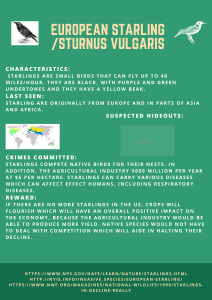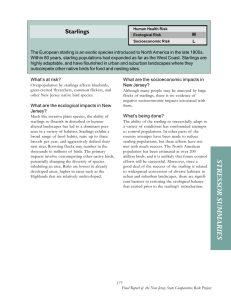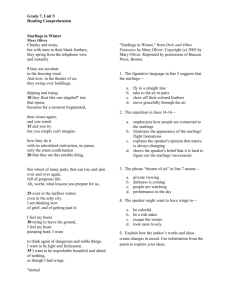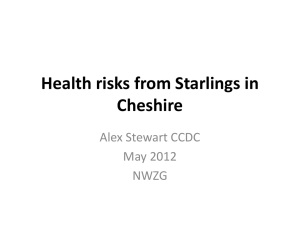starlings - WWF Australia
advertisement
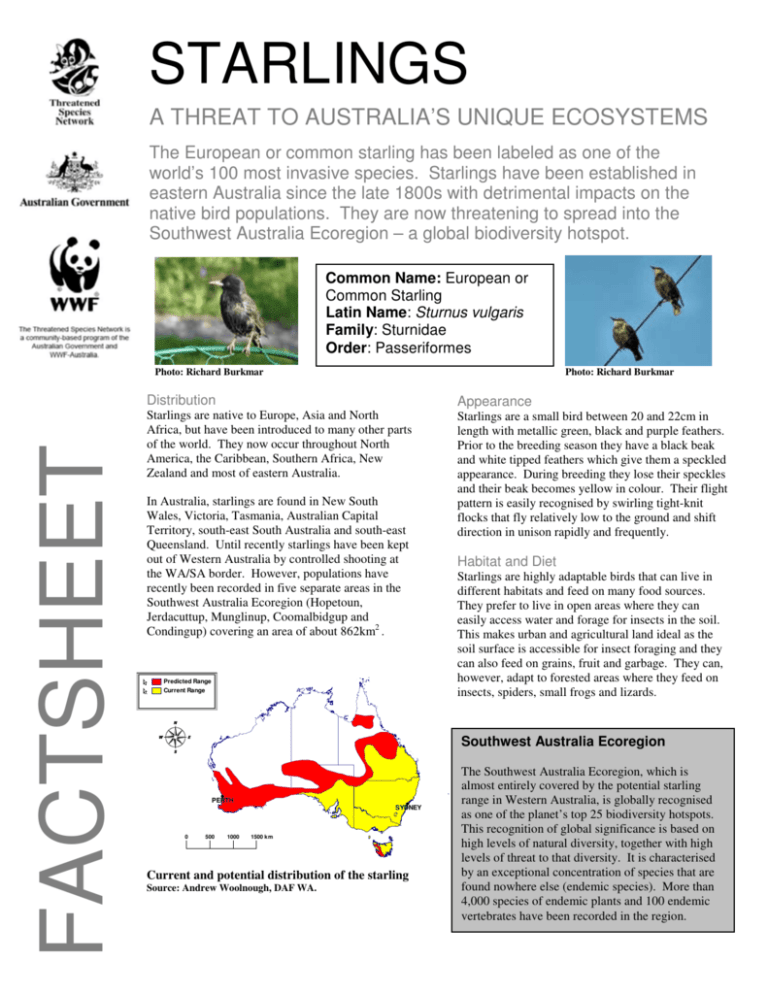
STARLINGS A THREAT TO AUSTRALIA’S UNIQUE ECOSYSTEMS The European or common starling has been labeled as one of the world’s 100 most invasive species. Starlings have been established in eastern Australia since the late 1800s with detrimental impacts on the native bird populations. They are now threatening to spread into the Southwest Australia Ecoregion – a global biodiversity hotspot. Common Name: European or Common Starling Latin Name: Sturnus vulgaris Family: Sturnidae Order: Passeriformes Photo: Richard Burkmar Photo: Richard Burkmar FACTSHEET Distribution Starlings are native to Europe, Asia and North Africa, but have been introduced to many other parts of the world. They now occur throughout North America, the Caribbean, Southern Africa, New Zealand and most of eastern Australia. In Australia, starlings are found in New South Wales, Victoria, Tasmania, Australian Capital Territory, south-east South Australia and south-east Queensland. Until recently starlings have been kept out of Western Australia by controlled shooting at the WA/SA border. However, populations have recently been recorded in five separate areas in the Southwest Australia Ecoregion (Hopetoun, Jerdacuttup, Munglinup, Coomalbidgup and Condingup) covering an area of about 862km2 . Predicted Range Current Range Appearance Starlings are a small bird between 20 and 22cm in length with metallic green, black and purple feathers. Prior to the breeding season they have a black beak and white tipped feathers which give them a speckled appearance. During breeding they lose their speckles and their beak becomes yellow in colour. Their flight pattern is easily recognised by swirling tight-knit flocks that fly relatively low to the ground and shift direction in unison rapidly and frequently. Habitat and Diet Starlings are highly adaptable birds that can live in different habitats and feed on many food sources. They prefer to live in open areas where they can easily access water and forage for insects in the soil. This makes urban and agricultural land ideal as the soil surface is accessible for insect foraging and they can also feed on grains, fruit and garbage. They can, however, adapt to forested areas where they feed on insects, spiders, small frogs and lizards. Southwest Australia Ecoregion PERTH 0 500 1000 SYDNEY 1500 km Current and potential distribution of the starling Source: Andrew Woolnough, DAF WA. The Southwest Australia Ecoregion, which is almost entirely covered by the potential starling range in Western Australia, is globally recognised as one of the planet’s top 25 biodiversity hotspots. This recognition of global significance is based on high levels of natural diversity, together with high levels of threat to that diversity. It is characterised by an exceptional concentration of species that are found nowhere else (endemic species). More than 4,000 species of endemic plants and 100 endemic vertebrates have been recorded in the region. Breeding The starling breeding season occurs mainly in spring and summer, from September to December, but can be anywhere between July and March. Starling pairs find cavities in trees, shrubs, cliffs or buildings to build nests made of twigs, grass, feathers and moss. They lay between four and eight eggs and can raise up to three broods per season. Competition with Native Hollow-nesting Birds Roosting Habits Any impact that a single starling can have is magnified many times because they congregate in such large numbers - up to 150,000 birds. They can defoliate, destroy and foul the trees they roost in and plants below. They also roost in wetlands and contaminate water with their droppings. In such enormous flocks they can spread many seeds and displace many native hollow-nesting birds or mammals. Starlings aggressively take over and defend hollows suitable for nesting. Less aggressive birds with similar nesting time and nest size are at greatest risk of displacement. In North America and eastern Australia, starlings have been linked to the decline of many hollow-nesting birds. A study conducted in New South Wales showed that starlings occupied 34% of available natural nesting hollows, displacing a number of species of native parrots. There are about 30 native hollow-nesting bird species in the Southwest Australian Ecoregion potentially at risk of nest-site competition if starlings establish in areas critical to these species. Particularly at risk are western rosella, Carnaby’s and Baudin’s black cockatoos, Muir’s corella, purple-crowned lorikeet, red-capped parrot, elegant parrot, and blue bonnet. Dispersal of Weed Seeds Starlings eat many different fruits and berries and can fly very long distances from feeding to roosting sites making them ideal weed spreaders. Weeds that they are known to spread in eastern Australia include olives, bridal creeper, bitou bush, boneseed, and blackberry, most of which are already problem weeds in the Southwest Australian Ecoregion. Many weed seeds germinate better after they have been through a bird’s digestive system. Invasive weeds are more efficient at using resources such as water and nutrients and can crowd out native plants, thereby changing the balance and structure of the ecosystem. A flock of starlings head to their evening roost site Photo: Jose L. Gomez de Francisco, National Geographic Stopping the Starling Starlings are being monitored in the Southwest Australia Ecoregion, and various methods are being used to eradicate the birds found. Birds are also being radio-collared to lead observers to any larger flocks which are then trapped or netted. Key organisations involved in stopping the starling are the WA Departments of Agriculture and Food (DAF) and of Environment and Conservation (DEC), Birds Australia, and the South Coast Regional Initiative Planning Team (SCRIPT) regional NRM group. The late 2006 breeding season is critical in the prevention of further expansion of the starlings’ territory further west into the Southwest Australia Ecoregion. Action is urgently needed to stop starlings invading this important area. How You Can Help • • • If you see a starling in Western Australia, please report it to the Department of Agriculture and Food’s Pest Hotline: 1800 084 881. Encourage native birds by planting native vegetation in your garden. Protect old growth habitat that contains nesting hollows. Bridal creeper is spread by starlings Photo: Peter Turner, CSIRO For more information contact: WWF-Australia, National Office Ph: 1800 032 551 Fax: 61 2 9281 1060 Email: tsn@wwf.org.au Or Threatened Species Network WA WWF-Australia. Perth Office Ph: 08-9387-6444 Email: tsnwa@wwf.org.au
